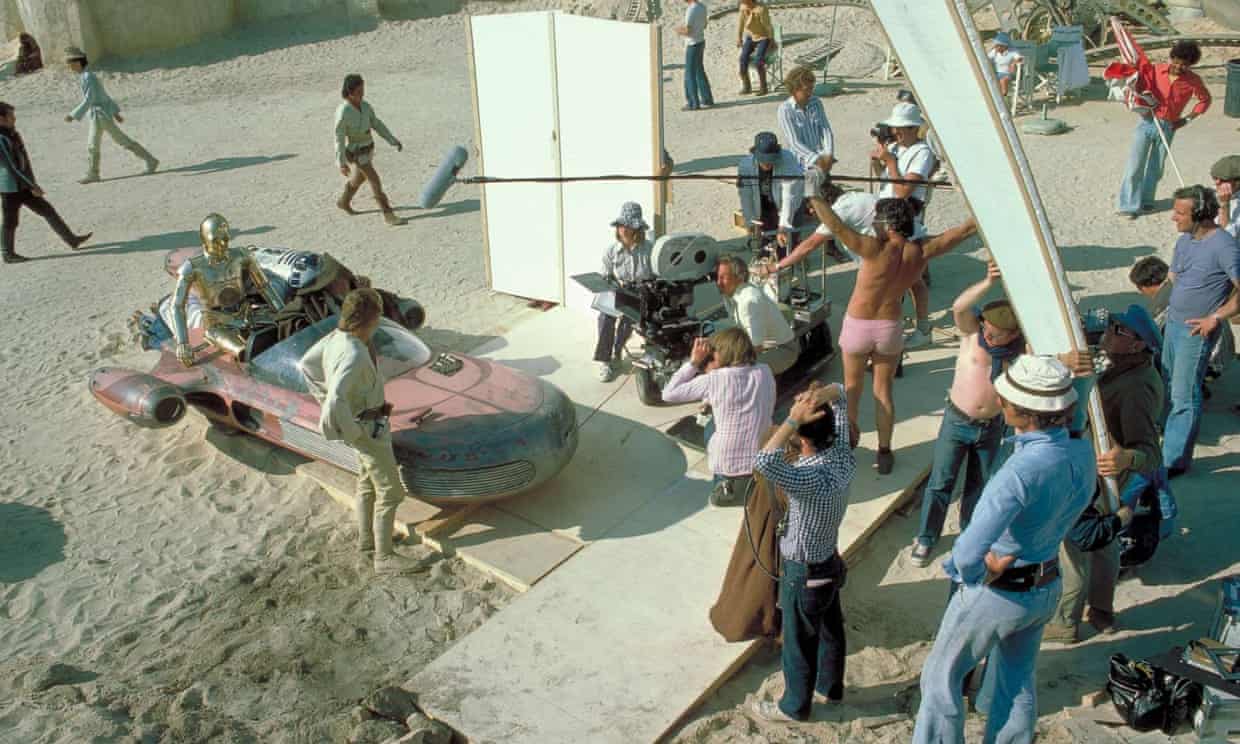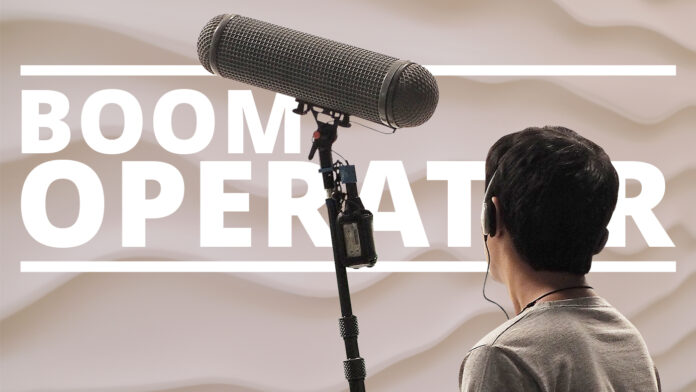In a nutshell
- A boom operator is responsible for capturing high-quality audio on set, primarily by positioning and operating a boom microphone to capture dialogue and other sounds
- The boom operator works closely with the director, cinematographer and other members of the production team to ensure that the audio captured is of the highest quality possible
- Boom operates need to have the skill and physical stamina to minimize handling noise
Have you noticed a large pole hanging above a film shoot with what looks like a cat’s tail at the end? And what about the person holding it? That pole is a boom pole, a long pole with a microphone attached to record audio. The “cat’s tail” is a dead cat, synthetic fur that covers the microphone and blocks wind, reducing wind noise. These are all standard tools for boom mic operators.
In this article, we will examine what a boom mic operator does and why they are essential to every successful film production.
What is a boom operator?
A boom operator plays a central role in the sound department of film production. Their primary responsibility is microphone placement. A great boom operator excels at holding the microphone as close to the actor or action as possible without the microphone or boom pole entering the camera frame. They work closely with the camera operator, director, actors and other production teams.
A film director with a temper started it all
In 1920, microphones were typically hidden somewhere on the set. On one occasion, while filming “Beggars of Life” (1928), director William A. Wellman became angry with his soundman because the engineer insisted on keeping the microphone stationary. The director wanted a tracking shot of two actors walking the streets. So, in a fit of temper, Wellman took the microphone, hung it on a broom handle and ordered the sound engineer to move with it. Afterward, film productions began implementing boom poles, opening up many new possibilities for capturing audio.
What is their job?

A boom operator records audio, including actors’ voices or other on-set sounds. When an actor walks or runs, the boom operator follows them with the boom mic while remaining out of frame. The boom operator may use a boom stand to hold the pole when the shot is static.
A boom operator’s essential skill is deciding where to place the microphone based on the location and camera position while avoiding unwanted noises. That’s why boom operators need to familiarize themselves with the script so they can prepare to move the microphone’s position when different actors are talking and to have a general understanding of the scene composition. The boom operator must have a high level of skill, knowledge of various microphones, and an overall understanding of camera lenses. Additionally, boom operators must be diplomatic and have good people skills since they work with multiple actors and departments. Finally, but certainly not least, the operator needs a good level of physical fitness, strength and stamina. It takes a lot of energy to hold a boom mic steady for hours on end.
Equipment they use
A boom operator uses various audio equipment to record high-quality sounds. The most common tools include:
- Boom mic: any mic suspended on a boom pole; the most common boom mics are shotgun microphones (ideal for outdoor filming) and small diaphragm hypercardioid microphones (suitable for indoor filming)
- Boom pole: a pole usually made of aluminum that can generally extend between two to seven feet; some boom poles have internal coiled cables with an XLR connection at the base. The boom pole is handy for getting close to the actors or action without entering the frame
- Mic blimp: a wind-resistant cover that goes over the boom mic to reduce environmental background noises; this is also called a dead cat
- Shock mount: a mount that holds the mic in place and absorbs vibrations
- Headphones: a boom operator must have high-quality field and studio over-the-ear headphones that are comfortable to wear for long periods and have excellent audio monitoring capabilities
- Field recorder: used to record sound and ambiance; professional field recorders are multitrack, allowing operators to connect multiple mics at once and route audio to and from the camera; it is good to have a case for a field recorder to carry it over the shoulder and protect it from the elements
- Boom pole holder: gear suitable for fixing long-arm boom poles to C-Stands or mic stands; ideal for situations where the boom pole does not need to move
How do they hold boom poles?
There is no one perfect way to hold a boom pole to improve the effectiveness of a boom microphone. Depending on the situation, boom operators use different holding techniques. As long as the boom operator can capture the audio correctly without receiving an injury, it’s considered proper form. Ultimately, it’s all about getting the best-sounding results while keeping the boom pole/mic out of frame.
The most common technique is for the boom operator to hold their boom pole overhead with the mic pointing as close as possible to the talent. Both hands of the boom operator extend upwards, slightly shoulder-width apart.

Another way to hold the boom pole is by resting the pole on the operator’s shoulders and moving the microphone by twisting the pole or moving their body. This position is advantageous when the talent is far away for a long time. Additionally, an underhand position can be used to place the boom mic below the actors’ heads instead of above.
The critical skill of minimizing handling noise
Boom operators must be aware of any noises they make while handling the boom pole. Holding the boom pole can be extremely tiring on the shoulders. To rest, the operator may move the pole, causing unwanted noise in the recording. Some of the handling noises could be caused by XLR cables tapping the pole, the operator bumping into something, or simply by switching grips. A skilled boom operator will avoid unwanted noises as much as possible by moving carefully and monitoring/listening for mistakes with the headphones.
Famous boom operator: Ken Nightingall
Who could guess that a boom operator wearing only pink shorts would become famous? Such was the case of boom operator Ken Nightingall on the set of “Star Wars: Episode IV – A New Hope” (1977). The reason for wearing only pink pants was that the desert planet of Tatooine (the real-life desert of Tunisia) was very, very hot.

An integral part of every film
Hard-working boom operators are sometimes underappreciated. However, no film would be able to hit the big screen without the help of the boom operator. From assisting the sound recordist to attaching mics to actors and achieving the best audio quality for the production, the boom operator is a pivotal component to the success of a film.








